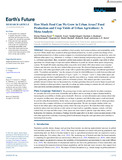JavaScript is disabled for your browser. Some features of this site may not work without it.
| dc.contributor.author | Payen, Florian Thomas | |
| dc.contributor.author | Evans, Daniel L. | |
| dc.contributor.author | Falagán, Natalia | |
| dc.contributor.author | Hardman, Charlotte A. | |
| dc.contributor.author | Kourmpetli, Sofia | |
| dc.contributor.author | Liu, Lingxuan | |
| dc.contributor.author | Marshall, Rachel | |
| dc.contributor.author | Mead, Bethan R. | |
| dc.contributor.author | Davies, Jessica A. C. | |
| dc.date.accessioned | 2022-09-13T15:41:19Z | |
| dc.date.available | 2022-09-13T15:41:19Z | |
| dc.date.issued | 2022-08-23 | |
| dc.identifier.citation | Payen FT, Evans DL, Falagán N, et al., (2022) How much food can we grow in urban areas? Food production and crop yields of urban agriculture: a meta-analysis. Earth's Future, Volume 10, Issue 8, August 2022, Article number e2022EF002748 | en_UK |
| dc.identifier.issn | 2328-4277 | |
| dc.identifier.uri | https://doi.org/10.1029/2022EF002748 | |
| dc.identifier.uri | https://dspace.lib.cranfield.ac.uk/handle/1826/18442 | |
| dc.description.abstract | Urban agriculture can contribute to food security, food system resilience and sustainability at the city level. Whilst studies have examined urban agricultural productivity, we lack systemic knowledge of how agricultural productivity of urban systems compares to conventional agriculture and how productivity varies for different urban spaces (e.g., allotments vs. rooftops vs. indoor farming) and growing systems (e.g., hydroponics vs. soil-based agriculture). Here, we present a global meta-analysis that seeks to quantify crop yields of urban agriculture for a broad range of crops and explore differences in yields for distinct urban spaces and growing systems. We found 200 studies reporting urban crop yields, from which 2,062 observations were extracted. ‘Lettuces and chicories’ were the most studied urban grown crops. We observed high agronomic suitability of urban areas, with urban agricultural yields on par with or greater than global average conventional agricultural yields. ‘Cucumbers and gherkins’ were the category of crops for which differences in yields between urban and conventional agriculture were the greatest (17 kg m-2 cycle-1 vs. 3.8 kg m-2 cycle-1). Some urban spaces and growing systems also had a significant effect on specific crop yields (e.g., tomato yields in hydroponic systems were significantly greater than tomato yields in soil-based systems). This analysis provides a more robust, globally-relevant evidence base on the productivity of urban agriculture that can be used in future research and practice relating to urban agriculture, especially in scaling-up studies aiming to estimate the self-sufficiency of cities and towns and their potential to meet local food demand. | en_UK |
| dc.language.iso | en | en_UK |
| dc.publisher | American Geophysical Union (AGU) - Wiley | en_UK |
| dc.rights | Attribution 4.0 International | * |
| dc.rights.uri | http://creativecommons.org/licenses/by/4.0/ | * |
| dc.subject | urban food growing | en_UK |
| dc.subject | food security | en_UK |
| dc.subject | growing systems | en_UK |
| dc.subject | urban spaces | en_UK |
| dc.subject | agricultural productivity | en_UK |
| dc.subject | urban resilience | en_UK |
| dc.title | How much food can we grow in urban areas? Food production and crop yields of urban agriculture: a meta-analysis | en_UK |
| dc.type | Article | en_UK |
Files in this item
The following license files are associated with this item:
This item appears in the following Collection(s)
-
Staff publications (SWEE) [2827]

